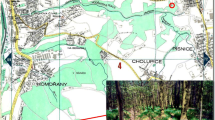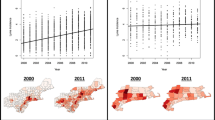Abstract
The human risk of contracting Lyme disease or other tick borne diseases transmitted by the tick species Ixodes ricinus is broadly linked to the tick nymph density. The study was performed in Rambouillet forest (Yvelines, France), a known focus of Lyme borreliosis, from January 1997 to December 1999. We used a nymph sampling methodology which permitted us to obtain a monthly nymph density index (from 0 to 5). Studying the seasonal nymph and larval activity patterns and estimating the larval developmental duration, we demonstrate the existence of an annual nymphal stock. Secondly, we elucidate how this stock is distributed throughout the year, month by month. Its distribution is principally dependent on two factors: the monthly mean ambient temperature and the proportion of active nymphs which find a host each month. Expected monthly nymph densities derived from a theoretical model describing the temperature-dependent stock distribution gave a good fit to the observed densities, accounting for between 76–86% of the monthly variation in observed nymph densities. Predicting the temporal distribution of nymph activity within a stable Lyme borreliosis focus enables more precise identification of risk periods.
Similar content being viewed by others
References
Clover, J.R. and Lane, R.S. 1995. Evidence implicating nymphal Ixodes pacificus (Acari: ixodidae) in the epidemiology of Lyme disease in California. Am. J. Trop. Med. Hyg. 53(3): 237–240.
Daniels, T.J. and Fish, D. 1995. Effect of deer exclusion on the abundance of immature Ixodes scapularis (Acari: Ixodidae) parasitizing small and medium-sized mammals. J. Med. Entomol. 32(1): 5–11.
Falco, R.C., McKenna, D.F., Daniels, T.J., Nadelman, R.B., Nowakowski, J., Fish, D. and Wormser, G.P. 1999. Temporal relation between Ixodes scapularis abundance and risk for Lyme disease associated with erythema migrans. Am. J. Epidemiol. 149(8): 771–776.
Gardiner, W.P. and Gray, J.S. 1986. A computer simulation of the effect of specific environmental factors on the development of the sheep tick Ixodes ricinus L. Vet. Parasitol. 19: 133–144.
Gray, J.S. 1991. The development and seasonal activity of the tick Ixodes ricinus: a vector of Lyme borreliosis. Rev. Med. Vet. Entomol. 79(6): 323–333.
Kitron, U. and Kazmierczak, J.J. 1997. Spatial analysis of the distribution of Lyme disease in Wisconsin. Am. J. Epidemiol. 145(6): 558–566.
Lees, A.D. 1948. The sensory physiology of the sheep tick, Ixodes ricinus L. J. Exp. Biol. 25: 145–207.
MacLeod, J. 1932. The bionomics of Ixodes ricinus L., the "sheep tick" of Scotland. Parasitology 24: 382–400.
MacLeod, J. 1934. Ixodes ricinus in relation to its physical environment. The influence of climate on development. Parasitology 26: 282–305.
Pérez-Eid, C., Pichon, B., Zhioua, E., Tremel, N., Villeret, R., Deruaz, D., Mousson, L., Vassallo, M. and Ferquel, E. 1998. Lyme borreliosis, emergent disease linked with the environment. Bull. Acad. Natl. Med. 182(2): 267–283.
Pichon, B., Mousson, L., Figureau, C., Rodhain, F. and Pérez-Eid, C. 1998. Density of deer in relation to the prevalence of Borrelia burgdorferi sensu lato in Ixodes ricinus nymphs in Rambouillet forest, France. Exp. Appl. Acarol. 23(3): 267–275.
Pomerancev, B.I. 1950. Fauna of U.S.S.R. Arachnida. Vol. IV, No. 2. Ixodid ticks (Ixodidae). The American Institute of Biological Sciences, Washington, 199.pp.
Stafford, K.C. 1993. Reduced abundance of Ixodes scapularis (Acari: Ixodidae) with exclusion of deer by electric fencing. J. Med. Entomol. 30(6): 986–996.
Vassallo, M, Pichon, B., Cabaret, J., Figureau, C. and Pérez-Eid, C. 2000. Sampling methodology for the questing nymph stages of Ixodes ricinus L. (Acari: Ixodidae), the principal vector of Lyme disease in Europe. J. Med Entomol. 37 (in press).
Varley, G.C., Gradwell, G.R. and Hassell, M.P. 1973. Insect Population Ecology. An Analytical Approach. Blackwell Scientific Publications, Oxford.
Zhioua, E., Postic, D., Rodhain, F. and Pérez-Eid, C. 1996. Infection of Ixodes ricinus (Acari: Ixodidae) by Borrelia burgdorferi in Ile de France. J. Med. Entomol. 33: 694–697.
Author information
Authors and Affiliations
Rights and permissions
About this article
Cite this article
Vassallo, M., Paul, R. & Pérez-Eid, C. Temporal Distribution of the Annual Nymphal Stock of Ixodes Ricinus Ticks. Exp Appl Acarol 24, 941–949 (2000). https://doi.org/10.1023/A:1010669003887
Issue Date:
DOI: https://doi.org/10.1023/A:1010669003887




